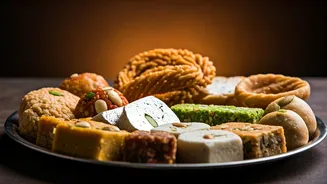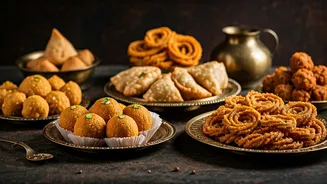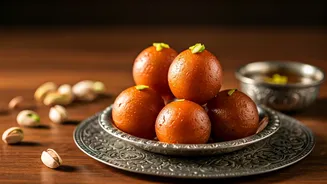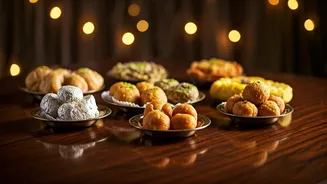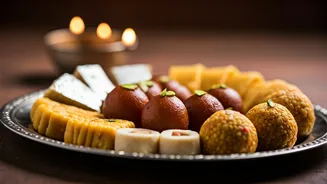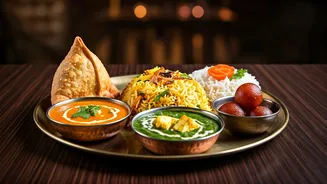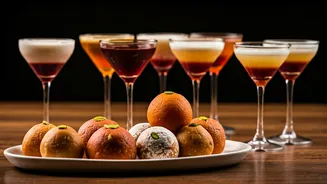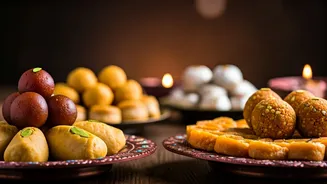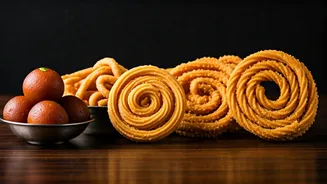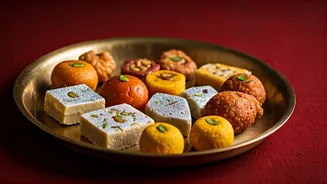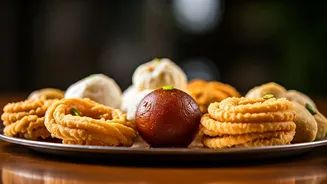Sweet Beginnings
The sweetness of Diwali is as iconic as the lights themselves. Traditional sweets take center stage, each with a unique story and regional variation. For
instance, Ladoo, a ball-shaped confection, made with gram flour, sugar, and ghee, is a staple, particularly the Motichoor Ladoo and Besan Ladoo. Gulab Jamun, deep-fried milk balls soaked in rose-flavored sugar syrup, is a decadent delight, popular across India. Then there's Barfi, made from condensed milk or khoa, with various flavors like cashew, pistachio, and chocolate. Each sweet represents prosperity and joy, shared among family and friends during this auspicious occasion. Preparing these sweets is a labor of love, often involving multiple generations in the kitchen.
Savory Sensations
While sweets steal the limelight, the savory side of Diwali is equally appealing. Namkeen snacks, offering a satisfying crunch, are indispensable. Samosas, filled with spiced potatoes, peas, and often served with chutney, are a beloved favorite. Mathri, a flaky biscuit, offers a salty counterpoint to the sweetness. Chakli, a spiral-shaped snack made from rice or gram flour, adds to the variety. These snacks not only tantalize the taste buds but also provide energy for the long night of celebrations, allowing families to enjoy card games, firecracker displays, and social gatherings. Preparing savory snacks also symbolizes community, with friends and neighbors exchanging homemade treats.
Regional Specialties
Diwali cuisine reflects India’s diverse tapestry of cultures. The North Indian states, especially, celebrate with dishes like Dal Makhani (creamy black lentil curry) and Shahi Paneer (cottage cheese in a rich tomato-based gravy). In the West, Gujarat and Maharashtra prepare faral, a selection of fried and roasted snacks. South India serves up festive meals with a range of rice dishes, sambar (vegetable stew), and various chutneys. East India features sweets like Rasgulla (spongy cheese balls in syrup) and Sandesh (milk-based sweet). Each region adds its unique spin to the festive menu, ensuring a rich and diverse culinary experience. The variety celebrates the unity in diversity that India is famous for.
The Festive Feast
The main Diwali meal is a grand affair, a time for families to come together. The dishes vary greatly by region but often include a mix of vegetarian and non-vegetarian options. Rice and various types of rotis (flatbreads) are common. Vegetarian dishes often include paneer (Indian cheese) preparations, vegetable curries, and lentil-based dishes. Non-vegetarian options feature chicken or mutton curries. The meal is usually followed by a dessert spread that includes multiple types of sweets, ensuring a delightful end to the feast. A well-prepared festive meal symbolizes prosperity, happiness, and the blessing of the deities.
Significance of Food
Food at Diwali holds profound cultural and symbolic significance. It represents abundance and prosperity, essential for the well-being of the family. Offering food to deities is a common practice, a gesture of gratitude and reverence. Sharing food with family, friends, and neighbors fosters a sense of community and strengthens bonds. The act of preparing and consuming food together is an important element of the celebration, signifying togetherness and shared joy. Foods are often chosen based on their perceived auspicious properties, with certain ingredients and dishes believed to bring good fortune and positive energy. Thus, Diwali food goes beyond just sustenance; it becomes an integral part of the celebration's spirit.
Modern Twists
While traditional dishes remain a central part of Diwali cuisine, there's a growing trend towards innovation. Chefs and home cooks are experimenting with new flavors and ingredients, adding modern twists to classic recipes. This includes fusion dishes that blend Indian flavors with global cuisines, along with healthier versions of traditional sweets, reducing sugar and incorporating healthier ingredients. Presentation also matters: dishes are creatively plated to enhance their visual appeal. This fusion of tradition and modernity makes the Diwali culinary experience even more exciting, offering something for everyone. This evolution reflects the dynamic and adaptable nature of Indian cuisine.
